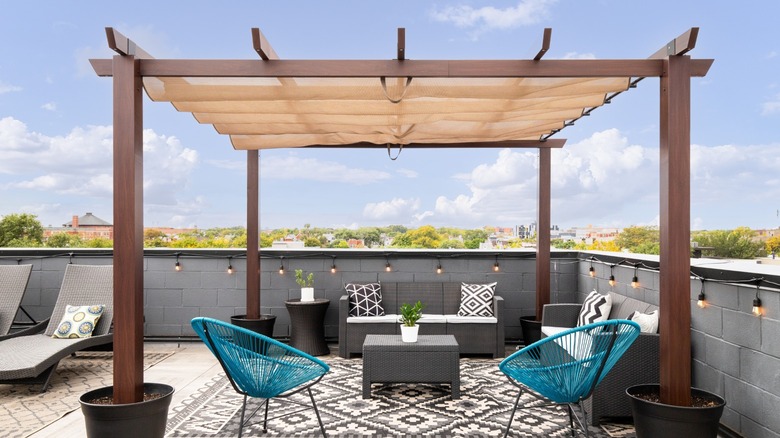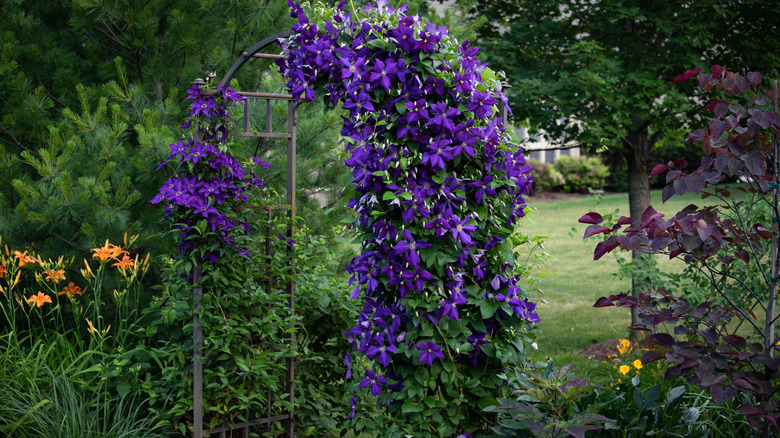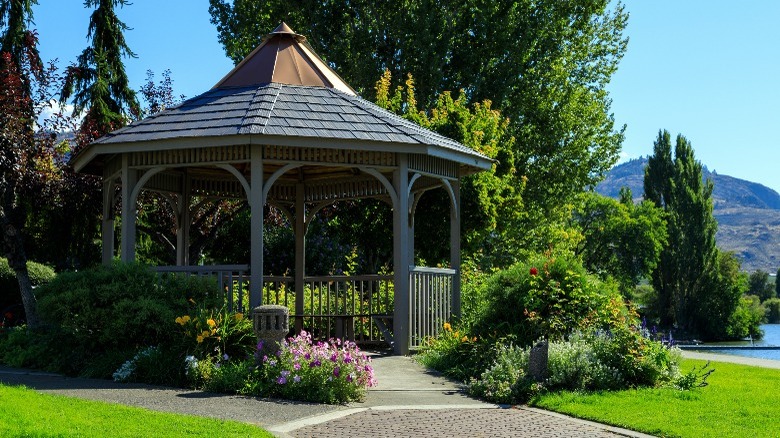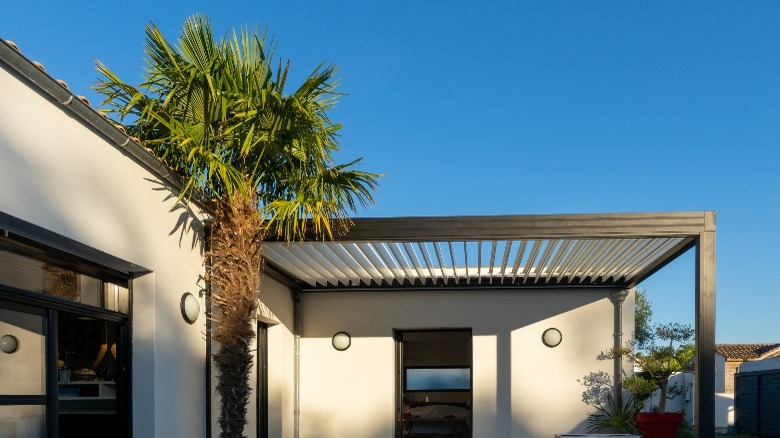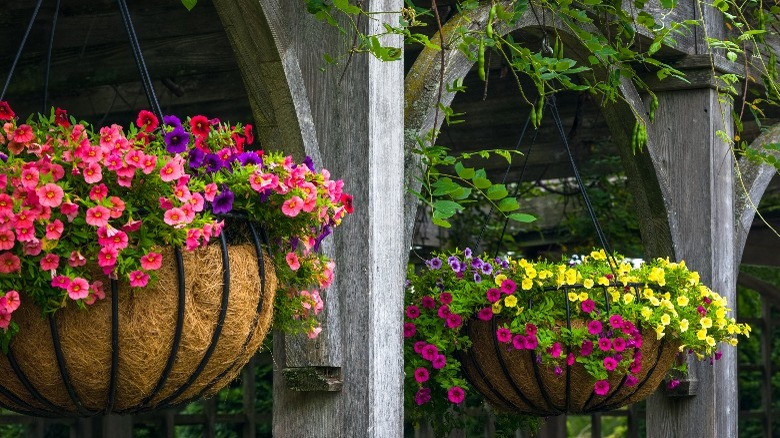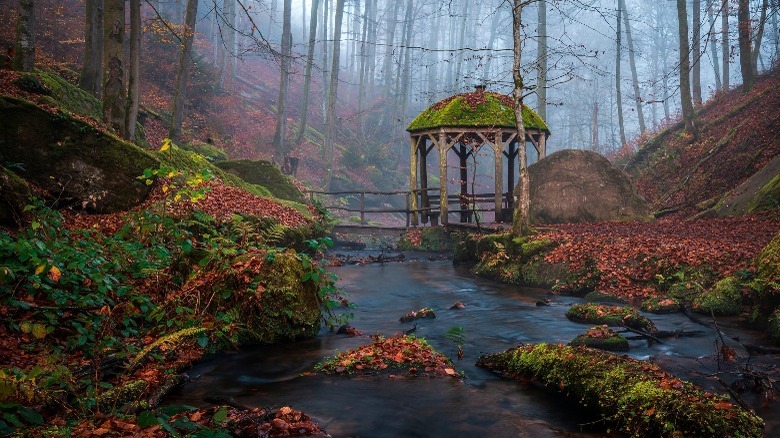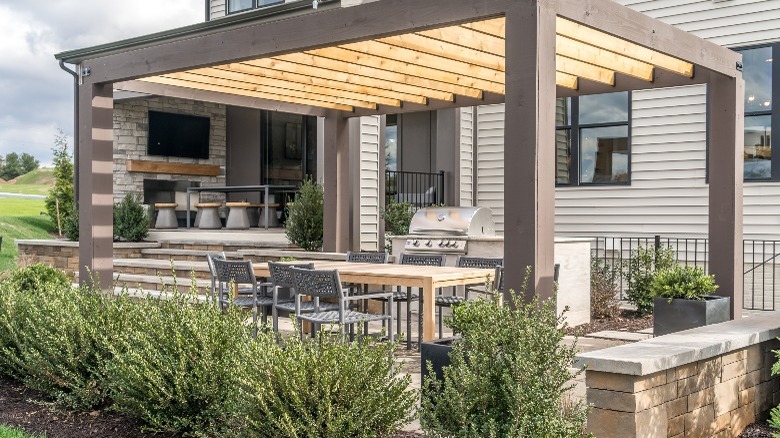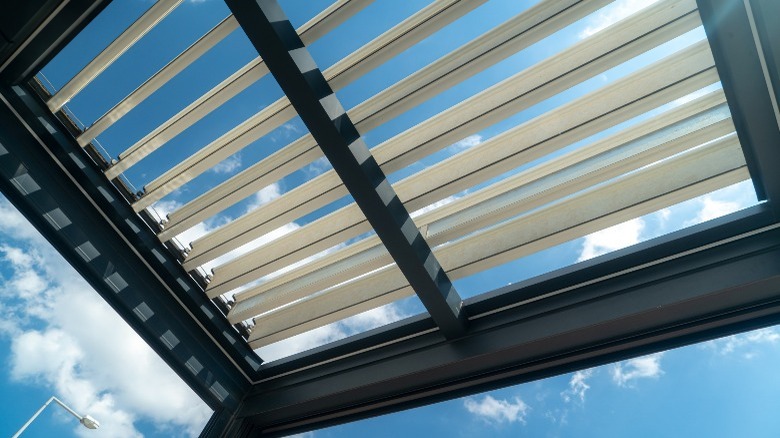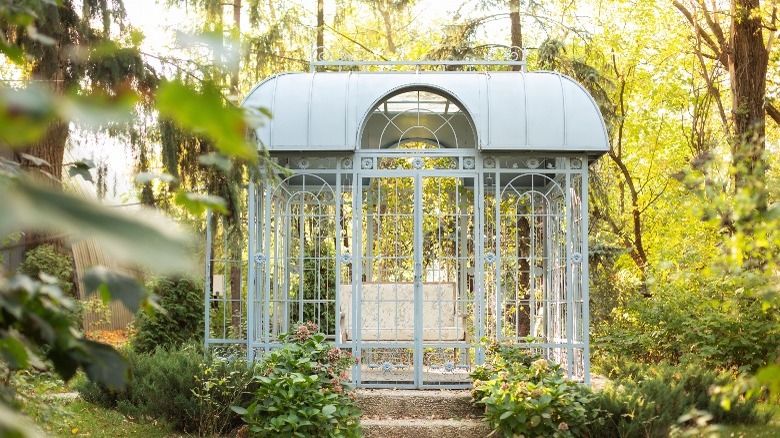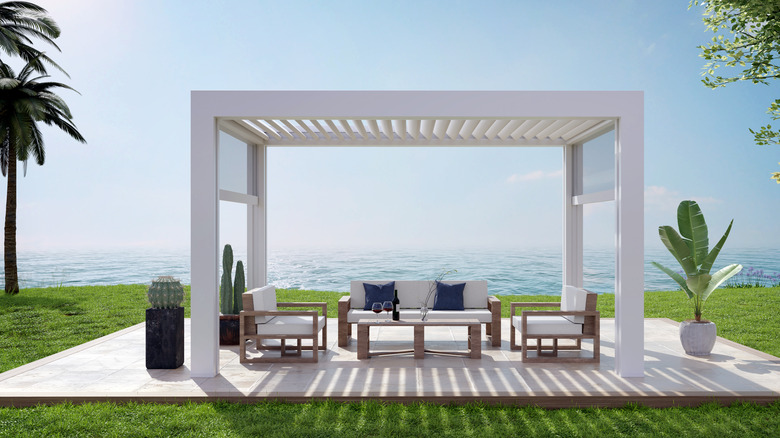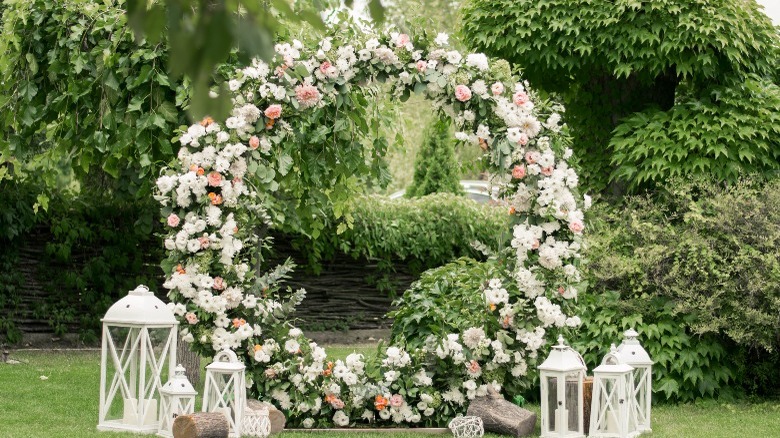Arbor Vs. Gazebo Vs. Pergola: What's The Difference?
We may receive a commission on purchases made from links.
If you've been trying to plan your outdoor space and have your eye on some kind of structure, whether you choose an arbor, gazebo, or pergola will depend on your end goal and personal preferences. According to Big Fish Contracting, doing an outdoor renovation can give your house a complete makeover, and increase your home value at the same time.
One of the great tips offered includes finding a contractor that specializes in outdoor renovations and offers all the services you'll need. This will reduce costs, time and scheduling, and headaches for you. Another piece of advice is to be sure to get several different quotes and speak to each contractor until you find someone you feel you can trust. Remodeling your outdoor space is exciting, so here are a few pieces of information that might help you decide exactly what type of structure you want.
What is an arbor and what's its purpose?
An arbor can be added to the exterior of the house anywhere you might want an added touch, and usually is described as an arch (via GreenUpside). They're great for growing vines on and are typically decorative, but come in a variety of shapes and sizes. They can also provide shelter or shade. Some people use more than one, as they can be used for separating or connecting outdoor areas. An arbor is smaller than a pergola, but bigger than a trellis.
Typically, an arbor is used as a landscaping feature and often has vines covering it, so it blends into the natural surroundings. It's used as shade for a garden bench, or as an entryway arch into the garden. Though it's generally pictured as an arch, it can also have a flat top or even a pointed one. An arbor can even be a relatively simple DIY project if you're feeling ambitious. Those who have elaborate outdoor landscaping will sometimes add an arbor for its aesthetic beauty.
What is a gazebo and what's its purpose?
According to Lancaster County Backyard, a gazebo is another type of outdoor stand-alone structure you can install for shade and decor purposes. It usually is an octagon shape and has a roof and rails around the sides, providing a sturdy shelter that's open and airy. A gazebo is not generally too large, but can house a small sitting area. Of course they can be uniquely designed for larger areas, as well. Typically, the roof has a cupola which makes the structure easily recognized as a gazebo.
Gazebos provide shelter and shade, and oftentimes a quiet spot for reading a book or having a discussion, or simply a platform for enjoying a particular aspect of your landscaping. They can really be as large or small as you want them, and they're great for hosting outdoor parties or events at your house, as well. You can put benches or seating inside, and they're even strong enough to hang a hammock inside if you like!
What is a pergola and what's its purpose?
So then what's a pergola? Great question! A pergola is like a freestanding porch, or outdoor entertainment area. Typically the largest of the three, a pergola can even be attached to the house, if you prefer. These structures have four main pillars and a roof, which can be designed in multiple ways. Generally, they are long and narrow patio-type shelters, unlike the others.
Obviously, a pergola is a bigger project than an arbor, or even many gazebos. There are multiple material types and different applications. They can be built as an add-on to a room that extends it into an outdoor area. They can be built as a cover for a terrace or patio, or they can act as a separate outdoor structure in your yard. You can put an outdoor kitchen under a pergola! There are different types of roofs, but traditionally they are a thatched style. However there are also louvered and retractable pergolas, and some have smart technology, too.
Pros and cons of an arbor
According to Wayfair, arbors can be made of different materials, such as wood, metal, vinyl, or iron. This gives you a variety of options for different budgets and design choices. An arbor is a good DIY project, and kits are available for most. You can also purchase a premade arbor from places like Home Depot.
Arbors make beautiful entrances to specific areas, such as the garden or a walkway, in your outdoor space. However, they don't provide much shade, and they will require quite a bit of maintenance. Additionally, it will take time to grow vines over an arbor if you're choosing it for that aspect. Arbors are not as sturdy as either a gazebo or a pergola, and are more for decorative purposes than practical ones.
Pros and cons of a gazebo
A gazebo is a larger outdoor structure that really complements your landscape, and provides a covered area for whatever you want to create. Traditional gazebos have a quaint look and unique shape and generally help to improve the aesthetics of the exterior of your property. But before even considering putting in a gazebo, you need to make sure you have enough space. They're great to accentuate the outer beauty of the premises, but shouldn't overcrowd the space.
Additionally, according to Mid Atlantic Deck and Fence, gazebos require more maintenance and are more expensive than pergolas or arbors. Although it's still a doable DIY project, it's much more complex than an arbor, or even a standard pergola. In particular, the geometric design can be challenging, and the roof can be vulnerable to extreme weather. A contractor will ensure that the gazebo is built sturdily and correctly. It's a significant investment but will increase your home value.
Pros and cons of a pergola
One of the common uses of putting in a pergola is to provide cover for outdoor spaces like patios, per Horticulture Magazine. But these structures are versatile and can be incorporated as an extension of the house, or as a stand-alone feature. You can grow vines and flowers on them as you can with arbors if you're going for that look. They are a terrific outdoor structure for larger areas, and usually increase home value.
According to Sunshine & Play, one big disadvantage is damage from insects and pests. If the pergola is made of wood, it will need to be sealed properly every couple of years to keep carpenter ants and termites away and better withstand the weather. And regardless of material, if there are plants growing on or near it, you'll have to be vigilant with pest control. Be aware that these structures are not meant to last forever, and will fade over time. While there are many options for pergola styles, traditionally they don't provide much weather protection and are open on the sides with a slatted roof.
Maintenance differences
No matter which outdoor structure you decide is best for your exterior home remodel, they're going to require regular maintenance. Of course, different materials can reduce or increase the difficulty, but any outdoor feature is subject to weather conditions, unlike indoor projects (via Best Pick Reports). An arbor is probably the simplest to maintain because it's the smallest structure, and will not need much except protectants on the material you choose. Metal or wrought iron will need a coat of paint to keep rust and corrosion out, and wood needs to be sealed. Plastic or vinyl will be virtually maintenance-free.
A gazebo, on the other hand, requires extensive regular maintenance, per Outdoor Living Today. You'll need to clean it both inside and out, and watch for nests in the roof area. Speaking of the roof, keep in mind that for this outdoor structure, it's important to inspect it for damage after any storm. It will need to be inspected twice a year for things like cracks, splits, mold, fungus, etc. For a pergola, we've discussed some of its maintenance, but according to Angi, they'll need to be cleaned and sealed every two to three years. If you choose aluminum, this material will be the least maintenance. Whichever type of outdoor structure you're considering, be sure to check out all the materials and styles available and their specific maintenance requirements.
Design differences
While arbors are the smallest of the three structures, they can accentuate a portion of the landscaping and provide a lovely aesthetic to your yard. It's like putting a doorway or an entrance to a section of particular beauty (via Gardening Etc.). If you're a gardener, you will find particular value in having an arbor in place for climbing plants and vines. For a gazebo or pergola, it's likely you'll have seating under them, and you can even add lighting if you plan to use the structure at night (via Backyard Discovery).
Pergolas in particular have many uses, sizes, and roof options depending on what the overall plan is. Gazebos are usually shaped differently from pergolas. Gazebos are often built in a round or geometric shape. They are freestanding structures and typically have an elevated platform or floor, rails, and sometimes benches inside around the outer edge. Pergolas are usually rectangular or square, and are most often used for covering patios or terraces. Speak to a contractor who can help you with both material choices and design options.
Real estate value differences
Now that you know all about these different types of outdoor features, you may be wondering about real estate value differences. According to Impact Landscapes, putting in an arbor or a pergola can indeed add value to your home. But determining how much value is a different story! Keep in mind any of these structures will add home value if kept up nicely, but there are many variations that will affect how much.
According to Yardistry Structures, a gazebo or pergola can significantly impact home value, especially when seating and lighting are included. In fact, having a beautiful gazebo or pergola on display can be the distinguishing feature that sells a house. Again, the overall design, size, materials, and accessories will play the largest part in determining the amount of value it will add. It's safe to say that of the three, an arbor is the least expensive and therefore adds the least value.
Cost differences
The possible deciding factor could be the differences in cost, depending on what you want to do with your outdoor remodel. The range in price to have an arbor professionally installed, according to Lawn Love, is between $1,430 and $4,075. The average is $3,500, but keep in mind you can buy a prefabricated arbor for as little as $115, and the cost can be significantly reduced by doing it yourself.
For a gazebo, Lawn Love estimates the cost as between $5,365 and $9,025, with an average cost of $7,590. However, a gazebo can cost as much as $27,000 with all the extras, but you can build your own if you dare, starting at just $325 for a simple design.
A pergola will cost between $2,100 and $6,000, and an average of $4,000, per Lawn Love. But pergolas have a wide range that can be as low as $1,050 and as high as $11,000. If you want to DIY, the cost of a kit ranges between $550 to $4,000 and they come with everything you'll need.
Keep in mind that these costs are only estimates, and the actual prices will be dependent primarily upon materials and square footage. Hopefully, this article has helped you understand the differences between an arbor vs. gazebo vs. pergola, so you can make a more educated decision for your exterior home remodel.
